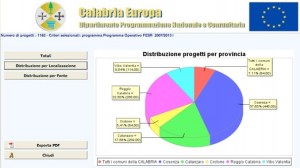Coordination between national and local policies is one of the key requirements of back office interoperability, joined-up services, Gov 2.0 initiatives. The post analyzes the delicate interaction between national and regional e-government policies in Italy from the 1990s to the present day.
Effective coordination and collaboration, both across different sectors (health care, transportation, education, etc.) and tiers of government (national or federal, regional, local), is widely recognized as one of the key requirements of advanced e-government implementation. At a back office level, coordination enables, for example, inter-agency data interoperability and sharing – including better-informed decision-making – and smarter public procurement through the aggregation of public ICT demand. At a front office level, information sharing allows the realization of so-called joined-up or seamless services, often delivered by local authorities, but linked to processes or data from higher levels of government. New flows of interoperable public data can also fuel government 2.0 initiatives, extending the sharing of information not only to other government organizations, but also to the public as active participants and services co-designer.
It is quite evident that policy design has a major role in supporting this process. E-government and ICT strategies should consider the coordination between central and local initiatives as the key factor preventing duplication of efforts and waste of public money, in accordance with the principle of subsidiarity. A common policy framework is needed to ensure the compliance of local initiatives with national strategic objectives, to strengthen the structures dedicated to policy governance, to develop common standards, to exchange good practices and to support the weakest local administrations in managing technical and organizational change. Indeed, ensuring that no local agency is left behind is a worthwhile public goal both from an efficiency and equity point of view.
Clearly, coordination is particularly needed in presence of a highly fragmented government structure, which means complex governance. In this regard, Italy represents a good case. Italian agencies directly involved in the delivery of e-government services are more than 10 thousand: they include the ministries and other central public organizations and their local divisions, 21 regional governments, 109 provinces, more than 8,000 municipalities, plus hundreds of other local institutions such as local health care authorities, park authorities, etc.
In such a scenario, the regional level has usually been considered as the ideal scale for policy intervention on these topics (actually, the debate is always open and the matter quite complex). Furthermore, after the reform of the Italian Constitution in 2001, regional governments have experienced greater autonomy on various matters (e.g. health care), which were devolved from central government to regional administrations, and are now playing a central role in defining innovation policy priorities. Today the great majority of the ICT investments in Italy are funded by regional budgets. Nevertheless, the role of the national government remains pivotal because it can promote political commitment, common strategies, technical standards and a shared policy framework.
The following sections briefly examine the delicate interaction between national and regional e-government policies in Italy from the 1990s to the present day.
First phase, 1993-2000: ‘pioneering’
At the national level, from 1993 to 2000 the actors charged with decision-making on ICT and the public sector were the Authority for IT in the Public Administration (AIPA) and the Minister of Public Administration. The AIPA – transformed in CNIPA (National Centre for IT in the Public Administration) in 2003 and than in DigitPA in 2009 – is a technical body with autonomy and scrutiny independence that, together with the Ministry of Public Administration shared some early competences over strategies and technical support in the development of information systems within the central administration. In the late nineties the Ministry launched a series of reforms towards efficiency and transparency of the public administration, which started to consider the ICTs as a carrier of modernization.
At the local level, no formal regional plan were conceived until 1999. In the second half of the nineties the first ‘civic networks’ were created in medium-sized municipalities – traditionally the most innovative and efficient – by the pioneers of e-government, who often were just individual enthusiastic civil servants with a technological background.
Second phase, 2001-2005: ‘a shared vision’
With the change of government in charge, a Ministry of Innovation and Technology was created. While the most advanced regions were drafting their e-government and information society plans, the Minister, together with the CNIPA, had the role of coordinating the implementation of the National e-government Action Plan (2001). The first phase of the plan culminated in a major bid for developing local public on line services (worth €472 million of national funding), through which about a hundred pilot projects were co-funded by the central government with more than 5.000 local agencies involved. The CNIPA was responsible for project selection and in-itinere evaluation, experimenting a result-driven funding. Overall, the implementation of the action plan has been characterized by a reasonably good level of collaboration between national and local levels and the importance of the inter-agency cooperation was explicitly documented in the national policies for the first time. In 2003, a document entitled A shared vision, a cooperative implementation (L’e-government per un federalismo efficiente: una visione condivisa, una realizzazione cooperativa) was approved by the Conferenza Unificata, a cooperation body representing the State, the Regions and the other local governments.
Other organizational bodies dedicated to inter-institutional coordination (all created in 2002) included a Permanent Commission for e-government (Commissione permanente) composed by the Ministry and the Presidents of the Regions, two Permanent Committees (Comitati permanenti) with the representatives of the Municipalities and the Provinces, a Joint Table for e-government (Tavolo Congiunto Permanente) composed by the Minister of Innovation, the Regions, the Provinces, the Comunità Montane (associations of municipalities located in mountain areas) and the central administrations involved in the Action Plan.
In 2002 a network of technical bodies was created for each region: the Regional Competence Centers for e-government (CRC), working teams designed to support the developing of e-government projects in local administrations. Collaboration between the Ministry and the Regions was facilitated by the presence of one or more representatives of both institutions in each regional team, while a central staff in Rome was assisting regional bodies in pursuing common goals and ensuring the comparability of the data collection activities that every CRC carried out to support decision-making.
Third phase, 2006-2008: ‘regional leadership’
Once the first phase of the Action Plan was completed, a change of national government occurred. The Minister of Public Administration inherited the powers of the Minister of Innovation and Technology, in order to better integrate the actions towards the diffusion offront office e-government services with those towards the back office re-engineering. In 2006 a new commission of the Conferenza unificata was set up: the Permanent Commission on technological innovation in the regions and local administrations.
In those years, the Minister of Regional Affairs also launched a second parallel national program for local e-government called ‘Elisa’, worth about €40 million of national co-funding, while the main action carried out by the CNIPA within the second phase of the Action Plan was the creation of the Alliances for Innovation (Alleanze per l’Innovazione), technical shared centers providing e-government services for small municipalities and co-financed by the central government.
A lower investment from the national level compared with the resources programmed in the previous years, together with a series of delays in implementing and coordinating the second phase of the national Action Plan, increased the role of regional policies in the whole implementation of e-government in Italy. This caused, especially in the Centre-North, afragmentation of local initiatives and, in the South, a much stronger weight of the Regional Cohesion Policy in defining strategies and policy priorities. Indeed, European Structural Funds and the National Under-utilized Area Funds (FAS) have been the main (often the only) source of funding for promoting the information society in the South of Italy, with more than €1.2 billion of total funding dedicated to e-government development in the 2000-2006 programming period. An additional €1 billion is programmed for the 2007-2013 period (Structural Funds only).
Fourth phase, from 2009 onwards: ‘one-to-one coordination’
In January 2009 the new Minister of Public Administration launched the national plan ‘e-gov 2012’. The plan covers 27 strategic objectives and 80 different initiatives and has suffered from a shortage of financial resources due to the particular condition of Italian public finance after the crisis, though €1.4 billion has been planned to be utilized over five years. E-gov 2012 is mainly focused on the digitalization of central government; however, some initiatives must be implemented in cooperation with the local government, e.g. the integration of the municipal registers with the real estate cadastral system and the regional topographic database.
Even if the previous bodies dedicated to central-local cooperation remain active, the cooperation between national and local governments has been realized mostly through the signing of several protocols of understanding between the Department of Innovations in the Public Administration, representing the Minister, and each single local government. According to the e-gov 2012 official web site, to date 23 protocols have been signed with local administrations (4 regions, 5 provinces and 16 municipalities).
The regions’ need to converge upon a common framework gave rise to the proposal of a plan named e-gov 2010, approved by the Inter-regional Center for IT, Statistical and Geographical Systems (CISIS) in March 2009. The plan, originally conceived as an anti-crisis measure, put at the centre of regional policy inter-regional cooperation in order to prevent the duplication of the technological platforms, solutions and services developed at the local level.
In April 2009 a protocol of understanding between the Minister and the Conferenza delle Regioni e Province Autonome, another body representing the Italian Regions, is aimed at fostering a constant dialogue through the creation of permanent links between the two levels of government. A similar document has been signed with ANCI, the National Association of Italian Municipalities, introducing more concrete actions such as the promotion of the certified e-mail and the national projects Linea Amica (a unified call-center of the whole Public Administration) and Reti Amiche (aimed at improving the delivery of public services by multiplying the access points, e.g. the involvement of banks and tobacconists).





